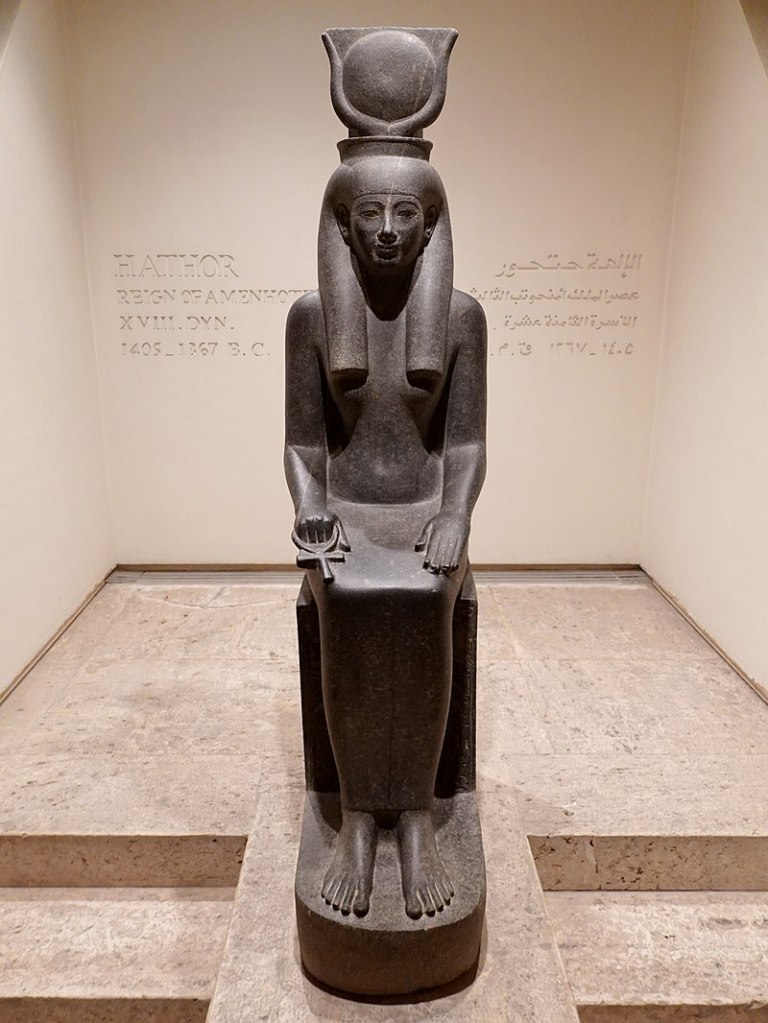Hathor
Hathor, a prominent goddess in ancient Egyptian mythology, held sway over a wide array of domains, embodying aspects of the sky, music, dance, joy, love, sexuality, and maternal care.
Often depicted as a cow or as a woman with cow’s horns holding a sun disk, Hathor was revered for her nurturing and protective nature. She was celebrated as the patroness of music and dance, presiding over festivities and joyous gatherings. Hathor’s influence extended to matters of love and sexuality, where she was invoked for fertility and guidance in matters of the heart. As a maternal figure, Hathor was believed to offer comfort and support to those in need, embodying the nurturing qualities associated with motherhood.

Symbols: Cow, cow horns, sun disk, sycamore tree, cobra.
Cult Centre: Dendera and Memphis
Parents: Ra
Consort: Ra, Horus, Atum, Amun, Khonsu
Children: Horus the child, Ihy and Neferhotep
Greek equivalent: Aphrodite
Roman equivalent: Venus
Roles of the Goddess
Sky Goddess: Within the cosmic framework of Egyptian mythology, Hathor, often depicted as a cow, assumed the role of a divine mother goddess. She was revered as the cow who gave birth to the sun god and cradled him between her horns, symbolizing the nurturing and protective forces of creation. Much like Nut, the sky goddess, Hathor was associated with the continuous cycle of birth and rebirth, heralding the dawn by bringing forth the sun god anew each day. This sacred imagery reinforced the interconnectedness of cosmic elements and underscored Hathor’s role as a maternal figure and a harbinger of light and life.

Solar Goddess: Hathor’s multifaceted nature encompassed various divine roles, including that of the Eye of Ra, a potent symbol representing the sun’s radiant power and Ra’s omnipotence. As the Eye of Ra, Hathor embodied the feminine essence of the sun disk, serving as an extension of Ra’s divine authority. Intriguingly, depictions of Ra situated within the sun disk suggest a symbolic interpretation wherein the Eye goddess assumed the role of a cosmic womb, birthing the sun god anew each day. This symbolic imagery underscores Hathor’s pivotal role in the cyclical rhythm of creation and renewal, mirroring the daily journey of the sun across the sky. Hathor’s portrayal as both mother, wife, and daughter of Ra encapsulates the intricate interplay of cosmic forces within Egyptian mythology, where divine relationships mirror the eternal dance of light and darkness, life and rebirth.

Music, Dance and Joy: Egyptian religion exalted the joys of existence, considering them divine blessings bestowed upon humanity by the gods. At religious festivals, Egyptians indulged in sensory delights, partaking in feasting, drinking, dancing, and music-making. Hathor, embodying the essence of celebration, was revered as the mistress of music, dance, and intoxicating pleasures. Her epithets, evoking images of garlands, myrrh, and merriment, emphasized her role in fostering joy and festivity. In hymns and temple depictions, musicians honored Hathor with the melodious strains of tambourines, harps, lyres, and sistra, resonating with the rhythmic pulse of life. The sistrum, in particular, held special significance in Hathor’s worship, its rattling sounds symbolizing the ecstatic union of creativity and fertility, echoing the eternal cycle of birth and renewal celebrated in Egyptian cosmology.

Maternal: Hathor was revered as the mother of various child deities, often depicted as both the mother and consort of Horus, echoing her dual role as both the king’s wife and the mother of his heir. In this aspect, Hathor embodied the mythic archetype of human queens. Comparisons between Hathor and the goddess Isis reveal significant contrasts. While Isis epitomized devotion to her husband and care for their child, representing a socially acceptable form of love, Hathor’s portrayal emphasized her uninhibited sexuality and joyful celebration of life.







2. Ptolemaic plaque of a woman giving birth assisted by two figures of Hathor. From Dendera.
3. Hypostyle hall of the Temple of Hathor at Dendera, 1st c. AD.
4. Statue of Hathor with a goddess personifying the Fifteenth Nome of Upper Egypt and the Fourth Dynasty king Menkaure; 26th c. BC. Museum of Fine Arts, Boston.
5. Mirror with a face of Hathor on the handle, 15th c. BC. Metropolitan Museum of Art.
6. Naos sistrum with Hathor’s face and the name of Ptolemy I, c. 305–282 BC. Metropolitan Museum of Art.
